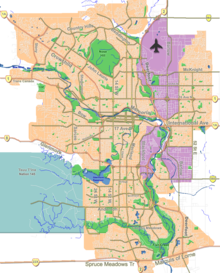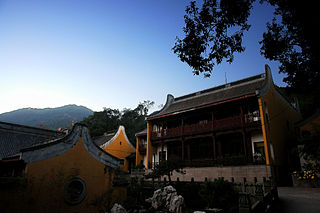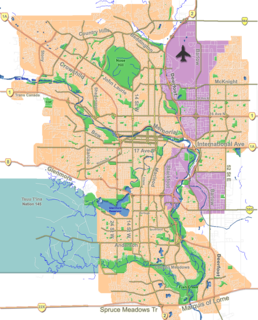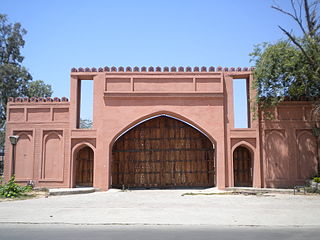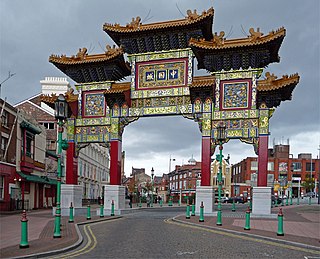Chinese Cultural Centre | |
| Established | 1992 |
|---|---|
| Location | |
| Coordinates | 51°03′06″N114°03′56″W / 51.051667°N 114.065556°W |
| Type | Cultural Centre |
| Website | http://www.culturalcentre.ca/ |
The Chinese Cultural Centre is a building in Calgary, Alberta, Canada. It is located on the north-eastern side of downtown and was completed in September 1992.

Calgary is a city in the Canadian province of Alberta. It is situated at the confluence of the Bow River and the Elbow River in the south of the province, in an area of foothills and prairie, about 80 km (50 mi) east of the front ranges of the Canadian Rockies. The city anchors the south end of what Statistics Canada defines as the "Calgary–Edmonton Corridor".

Alberta is a western province of Canada. With an estimated population of 4,067,175 as of 2016 census, it is Canada's fourth most populous province and the most populous of Canada's three prairie provinces. Its area is about 660,000 square kilometres (250,000 sq mi). Alberta and its neighbour Saskatchewan were districts of the Northwest Territories until they were established as provinces on September 1, 1905. The premier has been Rachel Notley since May 2015.

Canada is a country in the northern part of North America. Its ten provinces and three territories extend from the Atlantic to the Pacific and northward into the Arctic Ocean, covering 9.98 million square kilometres, making it the world's second-largest country by total area. Canada's southern border with the United States is the world's longest bi-national land border. Its capital is Ottawa, and its three largest metropolitan areas are Toronto, Montreal, and Vancouver. As a whole, Canada is sparsely populated, the majority of its land area being dominated by forest and tundra. Consequently, its population is highly urbanized, with over 80 percent of its inhabitants concentrated in large and medium-sized cities, many near the southern border. Canada's climate varies widely across its vast area, ranging from arctic weather in the north, to hot summers in the southern regions, with four distinct seasons.
Contents
The centre piece of the complex is the Dr. Henry Fok Cultural Hall, a building modeled after the Hall of Prayers of the Temple of Heaven in Beijing. The 70 foot (21 m) high ceiling is decorated with 561 dragons and 40 phoenixes. [1] It is supported by 4 columns with gold ornamentation representing each season. The outer surface of the dome is covered in blue tiles imported from China and crafted by the same company that endowed the Temple of Heaven during the Ming Dynasty 600 years ago. They were installed in traditional Chinese layered fashion and consolidated with mortar.

The Temple of Heaven is an imperial complex of religious buildings situated in the southeastern part of central Beijing. The complex was visited by the Emperors of the Ming and Qing dynasties for annual ceremonies of prayer to Heaven for good harvest.

Beijing, formerly romanized as Peking, is the capital of the People's Republic of China, the world's third most populous city proper, and most populous capital city. The city, located in northern China, is governed as a municipality under the direct administration of central government with 16 urban, suburban, and rural districts. Beijing Municipality is surrounded by Hebei Province with the exception of neighboring Tianjin Municipality to the southeast; together the three divisions form the Jingjinji metropolitan region and the national capital region of China.
The second level of the building contains classrooms and a library with books in Chinese and English (Orrin and Clara Christie Might Library). The main level hosts Dr. Henry Fok Cultural Hall, Henry G.D. Chow auditorium and a traditional Chinese medicine facility. There's also a restaurant and Chinese Artifacts Museum on the lower level.

